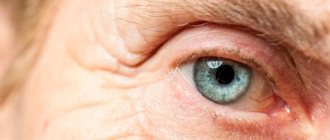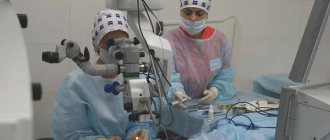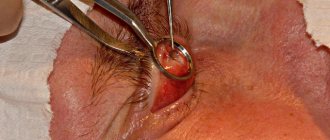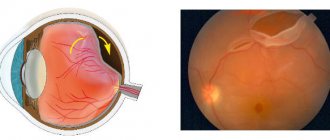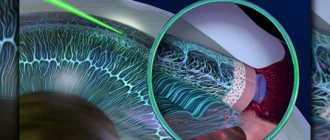Exophthalmos is a protrusion of one or two eyes forward, sometimes with deviation to the side. The eyeball itself does not increase in size. Exophthalmos is not an independent disease, but a symptom of various pathologies. It can appear at any age. What are the causes, can it be cured? We'll tell you more in the article.
Unilateral exophthalmos usually occurs with eye diseases, while bilateral exophthalmos is a sign not of ophthalmological, but of general disorders. Often these are pathologies of the thyroid gland and endocrine system. The degree of protrusion of the eyeball varies - from slight to very noticeable. What factors lead to this?
What is exophthalmos?
Protrusion in humans is accompanied by protrusion of the eyeballs from the orbital cavity.
However, this happens not due to correction of their sizes, but due to displacement of the visual apparatus. Women most often encounter pathology when they have problems with the thyroid gland. In men, the disease develops as a result of injury to the eye. With exophthalmos, the eyes protrude forward or move slightly to the side, depending on the location of the destructive processes occurring inside the organ of vision. Another characteristic manifestation of the disease is the formation of a white gap between the iris and the upper eyelid.
| The disease can develop over several years or appear in a couple of weeks. A severe form of the disease is visible to the naked eye. With ophthalmological abnormalities, exophthalmos affects one eye, with general pathologies in both. |
Treatment of exophthalmos
As a rule, it is carried out not by one, but by several specialists: an endocrinologist, an ophthalmologist, an oncologist, a neurologist, a neurosurgeon - usually two or three doctors conducting complex therapy.
In accordance with the cause of bulging eyes, as exophthalmos is also called, therapeutic measures are determined. So, with endocrine ophthalmopathy, it is necessary to restore normal functioning of the thyroid gland, so corticosteroids are prescribed.
For inflammatory processes in the eyes, antibacterial drugs are prescribed. In difficult cases, surgical intervention is resorted to. If the cause of exophthalmos is oncology, appropriate measures are taken: radiation or chemical therapy, surgery. In case of pronounced protrusion of the eyeballs, when there is a high probability of damage to the optic nerve, an operation is performed to partially remove fatty tissue from the orbit of the eye, which helps reduce pressure.
In order to prevent the occurrence of exophthalmos, you should protect your head from injury, be sure to conduct an examination after a blow or fall, treat diseases of the eyes and sinuses in a timely manner, maintain the vitamin balance in the body, and strengthen the immune system.
How to cure
Treatment of exophthalmos is aimed at eradicating the cause of its occurrence. Several specialists work with the patient. Among them are a neurologist, endocrinologist, otolaryngologist, neurosurgeon, and oncologist. Here are some basic treatment regimens for exophthalmos:
- If inflammation of the hypothalamus or pituitary gland is detected, the patient is advised to take antibiotics and sulfonamides. Sedatives are also used. A glucose solution is administered intravenously. A vitamin complex is prescribed. The areas of hormone production and the eye sockets are exposed to X-rays.
- When diagnosed with diffuse toxic goiter, diiodotyrosine, mercazolil, methylthiouracil, and radioactive iodine are prescribed.
- Edematous exophthalmos is treated with the same means as in the case of diffuse toxic goiter. In addition, radiotherapy is prescribed.
- Pulsatile exophthalmos is treated with local radiotherapy. After the procedure, a pressure bandage is applied to the eyes to thrombose the ophthalmic vein. If the disease is advanced, the carotid artery is ligated.
If exophthalmos is detected in one eye, treatment is carried out according to the recommendations of an ophthalmologist, since the unilateral manifestation of the disease is the result of diseases of the visual organs. Sometimes a physical defect is eliminated by surgical methods.
Exophthalmos: is surgery necessary for this disease?
Exophthalmos is a pathological displacement of one or both eyeballs forward, which is accompanied by difficulty in their movement, diplopia, burning sensations and excessive dryness of the conjunctiva. The treatment method for such a disease is determined by the nature of its occurrence; in general, surgical intervention is not required.
The most common causes of this pathological abnormality are endocrine disorders in the body and skull injuries. Treatment of exophthalmos is primarily aimed at eliminating the root cause as a result of which it arose.
It is important to know that the occurrence of such a disease does not depend on a person’s age, gender or type of activity. However, this disease significantly reduces the quality of life and causes a decrease in visual ability, and in some cases, in the absence of proper treatment, bulging eyes can develop into a malignant form.
Treatment methods for the disease will depend on the causes of its occurrence, the nature of its progression and severity. In most cases, this happens in a complex manner. Specialists such as an endocrinologist, neurosurgeon, neurologist, otolaryngologist and oncologist can help in the treatment process. Often people resort to plastic surgery to correct a physical defect, but this procedure is done at will and is not mandatory.
If doctors detect inflammation in the diencephalic area, the patient is prescribed anti-inflammatory drug therapy. It involves taking broad-spectrum antibiotics. For example, benzylpenicillin sodium salt, streptomycin sulfate, glucose is administered intravenously, sedative therapy is carried out. In addition, it is necessary to enrich the diet with vitamins, as well as undergo a course of radiotherapy on the orbit and diencephalic zone.
If the patient has exophthalmos on only one visual organ, then an ophthalmologist should find out the causes and prescribe treatment. This phenomenon is formed against the background of eye pathologies. When diagnosing diffuse toxic goiter, drug treatment is also prescribed. Edema exophthalmos is treated with medications and radiotherapy to the orbital area and pituitary zone.
When a corneal ulcer occurs, the causes of its appearance are first eliminated. For pulsating bulging eyes, radiotherapy is performed on local areas and a pressure bandage is applied. If the disease is severe, the doctor ligates the carotid artery.
It is very important to undergo routine examinations with a specialist in the future in order to promptly eliminate the problem in the early stages of its occurrence.
Classification
The disease is divided into imaginary and true:
- In the first case, the disease manifests itself with congenital asymmetry of the visual apparatus, abnormal development of the skull, or an increase in the palpebral fissure;
- True is diagnosed in case of inflammation and general pathologies, as well as in case of injury to the eye and the appearance of neoplasms.
According to the type of occurrence, exophthalmos is divided into the following categories:
- Constant. Most often it is diagnosed when malignant or benign tumors form in the orbit;
- Intermittent. Develops against the background of pathological processes occurring in the orbital veins. This form of anomaly is characterized by the fact that protrusion occurs only at a moment of strong physical stress, when the vessels are filled with blood. The pathology is most clearly visible if you tilt your head;
- Pulsating. Diagnosed with aneurysm and injuries of the visual apparatus. The main symptom of the disease is pronounced pulsation in the eye. A severe headache is also observed; when the eyelid is closed, a noise is recorded in the upper part of the eye. As the disease progresses, the veins on the forehead and temples become enlarged;
- Hypothalamic-pituitary. It is characterized by rapid development and manifests itself under the influence of increased production of the pituitary hormone. Within a few days, the eyelids swell and conjunctival chemosis begins.
In the absence of deviations, the eyeball extends beyond the orbit by a maximum of twenty millimeters.
| Depending on this parameter, mild, moderate and severe forms of exophthalmos are distinguished. In the first case, the eyes protrude by 21 - 23 mm, in the second the figure reaches twenty-seven millimeters, the severe stage is characterized by a deviation of up to 28 mm. |
Return to contents
Symptoms
With the exception of pathological protrusion, the symptoms of exophthalmos are very diverse:
- In inflammatory diseases, swelling of the nasal sinuses, mucous and soft membranes of the orbit is observed.
- Due to the increase in the size of the eyeball, a person is not able to close the eyelids tightly. In this case, the cornea is not moisturized naturally and is deprived of all protection.
- The defenseless eyeball is exposed to infection. Conjunctivitis develops and inflammation of the mucous membranes is observed.
- Due to pathological hypertrophy (enlargement) of the orbital tissues, the eyeball is compressed. A change in shape leads to the development of farsightedness.
- Progressive exophthalmos provokes increased activity of the lacrimal glands.
- In some cases, photophobia may develop.
- Pain and pain in the eyes are a sign of inflammatory processes with exophthalmos.
- Unilateral pulsating exophthalmos is accompanied by more pronounced pulsation.
- In case of complications, a split image occurs. A squint develops.
An unprotected cornea loses its function over time and is destroyed, leading to blindness. The atrophy process is accompanied by inflammatory foci of soft tissue.
With severe exophthalmos, the eyeballs bulge strongly forward, which leads to impaired mobility.
Symptoms of exophthalmos
The table will help you understand the symptoms of exophthalmos:
| A type of exophthalmos | Associated symptoms |
| Formed against the background of diffuse toxic goiter | Bilateral mild manifestation with preservation of eyeball mobility |
| Eye hurts | |
| The cornea is inflamed | |
| The upper eyelid may lag when looking down | |
| The frequency of involuntary eye vibrations sometimes decreases | |
| A white stripe of sclera may appear above the cornea if you look down | |
| Convergence of the eye may weaken or disappear when viewing an object at close range | |
| In severe cases, collections of pus or ulcers may form on the cornea | |
| Hypothalamic-pituitary | Swelling of the eyelids, which is characterized by suddenness and rapid progression |
| Weakening of the oculomotor nerves | |
| Edema of the conjunctiva | |
| Sometimes there is an increase in intraocular pressure and body temperature | |
| General deviations in body functions occur - carbohydrate metabolism disorders, mental disorders and others. | |
| Throbbing | Headache |
| Noise in ears | |
| Expansion of veins in the cheeks, forehead, neck, temples | |
| Papilledema | |
| Sometimes the eye muscles become paralyzed | |
| Intermittent | The symptoms are the same as in the case of pulsating exophthalmos, only in a mild form. |
In some cases of exophthalmos, it is impossible to close the eyelids. Because of this, the conjunctiva dries out and becomes inflamed. When the disease is advanced, swelling of the eyelids, decreased visual function, redness of the sclera and double image are observed.
Causes
The following factors can lead to the development of pathology:
- Glaucoma;
- Myopia of the third degree;
- Malignant neoplasms in the brain;
- The appearance of a tumor in the eyeball;
- Aneurysm of the vascular system of the main organ of the central nervous system;
- Fracture of bones in the orbital part of the eye;
- Inflammation of the paranasal sinuses;
- Thrombosis of the retinal vascular system;
- Hyperthyroidism.
Most often, bulging eyes are an acquired anomaly that develops as a result of previous eye or endocrine diseases.
Causes
The reasons are divided into general and local.
Local provoking factors include:
- Inflammatory processes in the orbit or adjacent areas. Local causes also include eye injury, pathology of the eye veins, and neoplasms in the eyeball area.
- Common causes are diffuse goiter, hydrocephalus, abnormalities of the skull, diseases of the hematopoietic system. Inflammation of the nasal sinuses can also be a provoking factor for exophthalmos.
Please note - treatment of Keratoconus. Effective complex techniques.
In the news (tyts) instructions for use of Aktipol eye drops.
Arutimol eye drops!
Classification of exophthalmos
By type:
1. Permanent : endocrine (thyrotoxic, edematous, myopathic), inflammatory, tumor, traumatic, allergic, tower skull, Crouzon's disease; 2. Pulsatile : caused by spontaneous or traumatic rupture of the internal carotid artery; 3. Intermittent : caused by varicose veins of the orbit.
On the side of manifestation, exophthalmos can be either unilateral (left or right) or bilateral.
According to its dynamics, exophthalmos occurs:
- non-progressive - for a long time, outward protrusion of the eyeball is not observed;
- slowly progressive - over the course of a month, the protrusion of the eye increases by no more than 2 mm;
- rapidly progressing - within a month there is an increase in the length of the protrusion of the eye by more than 2 mm;
- regressing - there is a decrease in the protrusion of the eyeballs.
According to the severity, exophthalmos is divided into 3 degrees :
- I degree - 21-23mm;
- II degree - by 24-26mm;
- III degree - by 27 mm or more.
What are the symptoms of exophthalmos
The clinical picture depends on the degree of protrusion of the eye. A slight deviation from the norm does not cause the patient any discomfort. As the disease progresses, the following symptoms appear:
- Swelling and redness of the sclera;
- Diplopia and decreased visual acuity;
- Since it is impossible to completely close the eyelids, the cornea dries out, which can lead to keratitis;
- Limited movement of the eyeball or its complete absence signals the formation of a neoplasm or activation of acute inflammation in the orbit;
- Increased lacrimation;
- Intolerance to bright light;
- When blinking, a person experiences pain.
| If the pathology is not treated, swelling of the optic nerve and its constant compression can lead to blindness. |
Edema exophthalmos
The reasons for the development of this form of the disease still remain poorly understood. To date, the etymology is clearly clear in only 70% of patients. In half of the cases, the pathological process is endocrine in nature. In 10%, the disease develops against the background of infection. Doctors associate the remaining 10% with the patient’s medical history and lifestyle.
The edematous form is characterized by severe protrusion of the eyeball. In most cases, the pathology is bilateral. Only 10% of patients have exophthalmos of one eye. In this case, the pain can be so severe that patients are prescribed narcotic painkillers.
If treatment is not started promptly, the disease can lead to keratitis. This is an inflammation of the cornea, in which vision rapidly deteriorates.
Definition of disease
Exophthalmos is a mono- or binocular displacement of the eyeball with its advancement forward; one or two eyes are affected at the same time. Medical code according to ICD 10: H06.2. In 90% of recorded cases, the problem is expressed in the fact that it is difficult for a person to move his eyes. There are manifestations such as diplopia (double vision), in some cases there is an added sensation of burning and stinging, which appears against the background of increased dryness of the mucous membranes.
The features and directions of therapy depend on the main reason that caused such changes in the location of the eyeball. The main medications that are included in the treatment program are thyreostatics and hormones (if disorders are identified in the endocrine system), as well as undergoing thyroidectomy if the drugs have shown low effectiveness.
If trauma has led to exophthalmos, drainage of the retrobulbar space is recommended to identify the underlying cause.
Causes
The main causes of occurrence are associated with disruption of the endocrine system (endocrine ophthalmopathy). The problem is based on a malfunction of the immune system, which entails problems such as:
- swelling of the subcutaneous fat of the orbit;
- swelling of the external muscles of the eyeball.
This form of disorder is called edematous. If the correct treatment methods are not used, the increasing changes will cause the formation of scars and other defects. They are noted on the extraocular muscles, so if delayed, changes in the organs of vision are irreversible.
Autoimmune changes affecting retrobulbar tissue (manifested against the background of Graves' disease) arise as a result of the response of antibodies to antigens of the thyroid gland and orbital tissue. They pass through a cross mechanism. During the examination, specialists in this case identify an increased level of antibodies.
In some cases, the disorder develops against the background of an isolated autoimmune lesion of retrobulbar tissue. In this case, pathological antibodies penetrate the muscles responsible for eye movement, fibroblasts and fiber of the orbit.
The cause of the development of exophthalmos is the increased number of antibodies to periorbital tissue. This is an important marker, since the increase in immunoglobulins to myocytes is not determined in all people. The following can also lead to violation:
- stressful situations and nervous overstrain;
- viruses;
- infections;
- penetration of toxins and poisons (their negative effects on the body);
- negative effects of radiation.
The trigger mechanism for exophthalmos can be inflammatory processes that have intraorbital localization. It is important to note that if there is inflammation of the fatty tissue or vasculitis of the blood vessels in the orbit, then exophthalmos occurs under the influence of mechanical processes. Developing benign or malignant tumors lead to the development of the pathological process.
Pathologies such as varicose veins, dacryoadenitis, angiopathy, and trauma can have a negative impact on the organs of vision and lead to disorders characteristic of exophthalmos.
Exophthalmos
Signs
The main symptom of exophthalmos is protrusion of the eyeball forward.
At the same time, its mobility may be maintained or limited. Exophthalmos may be accompanied by redness of the eyelid, swelling of the eyelid and conjunctiva. Often the eye is not only pointed forward, but also shifted to the side. Some types of exophthalmos, for example, with diffuse toxic goiter, are characterized by Graefe's symptom - a lag in the movement of the eyelid when looking down.
In many cases, diplopia (double vision) develops with exophthalmos. The fundus may remain unchanged, but more often exophthalmos is accompanied by neuritis, congestive disk, optic nerve atrophy and retinal hemorrhage. At the same time, vision decreases.
Also with exophthalmos there may be photophobia, lacrimation, and pain in the eyes.
With exophthalmos, the eyelids cannot always close tightly; this can cause drying of the eyes and the development of corneal dystrophy.
Description
Exophthalmos is a symptom of many congenital and acquired diseases. It can appear at any age, both in children and adults. It can develop in one eye or both. Moreover, with eye diseases, exophthalmos is often one-sided. And bilateral exophthalmos indicates mainly non-eye diseases, primarily diseases of the thyroid gland. The protrusion of the eyeball can be barely noticeable, or it can be very strong.
There are several types of exophthalmos:
- true exophthalmos occurs with inflammatory or tumor diseases of the orbit, as well as with endocrine diseases;
- imaginary exophthalmos occurs when the eyeball is enlarged, for example, with severe myopia, congenital glaucoma or abnormalities in the structure of the skull, asymmetry of the orbits;
- pulsating exophthalmos is observed with thrombosis of the cavernous sinus, eye injuries, or orbital artery aneurysm. At the same time, the eye moves in time with the pulse, and through the stethoscope you can hear a characteristic blowing sound;
- intermittent exophthalmos occurs when the head is tilted in case of certain diseases of the eye vessels, for example, with varicose veins of the orbit. May be associated with pulsatile exophthalmos
- progressive malignant exophthalmos occurs due to disruption of the hypothalamic-pituitary-thyroid complex, for example, with total removal of the thyroid gland.
There are many causes of exophthalmos:
- disruption of the endocrine system (endocrine ophthalmopathy);
- swelling of the orbit;
- orbital tumor;
- injuries with hemorrhage in the orbit;
- congenital glaucoma;
- inflammatory diseases of the lacrimal glands;
- paralysis of the external eye muscles;
- varicose veins of the orbit, vasculitis of orbital vessels;
- inflammatory diseases of the sinuses;
- some blood diseases;
- anomalies of skull development (tower skull);
- hydrocephalus.
Diagnostics
Only a doctor can diagnose exophthalmos during exophthalmometry, a study that evaluates the location of the eyeballs. A computed tomography or magnetic resonance imaging scan is performed to find out if there are any changes in the orbit that could cause exophthalmos.
They also do tests and studies necessary to determine the cause of these symptoms. Be sure to do a blood test for hormones and a study of immunity, an ultrasound examination of the thyroid gland, isotope diagnostics, and an X-ray examination of the diencephalic region and orbit.
Treatment
Treatment of exophthalmos depends on the underlying disease. If the cause is a disease of the thyroid gland, contact an endocrinologist. If exophthalmos occurs as a result of a tumor, it is treated by an oncologist. If the symptom appears due to diseases of the nasal sinuses, you need to contact an otolaryngologist.
If diseases of other organs rather than the eyes are to blame for the development of exophthalmos, then these organs need to be treated. In these cases, the help of a surgeon is often required.
Prevention
Prevention of exophthalmos consists in the prevention of those diseases of which it is a symptom. General rules of prevention: you need to monitor eye hygiene, promptly treat inflammatory diseases of the nose, protect your face, and especially your eyes, from injury. It is important to strengthen the body, do not abuse alcohol, do not smoke, avoid stress and eat right.
© Dr. Peter
Diagnostics
In principle, the disease can be detected with the naked eye. However, in the early stages the disease is not so pronounced, so to make an accurate diagnosis, doctors conduct a number of additional examinations:
- Exophthalmometry. Using a special device, the ophthalmologist determines the degree of protrusion;
- Using a slit lamp, the doctor performs a biomicroscopic examination;
- Magnetic resonance imaging of the brain;
- X-ray of the skull to exclude orbital fractures;
- Ultrasound examination of the visual apparatus;
- Using an ophthalmoscope, the doctor conducts a general examination of the eye;
- Computed tomography is performed to identify destructive processes in the eyes.
| An ultrasound of the thyroid gland, an x-ray of the organ of vision is also additionally prescribed, and blood is drawn for hormonal tests. |
Return to contents
Treatment
The diagnosis is made based on the clinical picture, anamnesis, and a full examination. Exophthalmometry allows you to determine the degree of protrusion.
For successful treatment, it is necessary to establish the underlying cause of the pathology, so the patient is treated not only by ophthalmologists, but also by endocrinologists, otolaryngologists, neurosurgeons, therapists, and neuropathologists.
The main direction of treatment measures is selected based on the identified cause of the pathology.
- For diseases of the thyroid gland, treatment is carried out by an endocrinologist. Microdoses of iodine, Mercazolil, and radioactive iodine are prescribed. The choice of drug depends on hormone tests. Depending on the level of hormones, pulse therapy using prednisolone may also be prescribed.
- For inflammatory phenomena, antibiotics, sulfonamides, vitamin therapy, and sedatives are used.
- Pulsating exophthalmos in case of injury is treated with the use of a pressure bandage, which allows thrombosis of the damaged vessel. Additionally, hemostatic agents are prescribed.
- Oncological tumors are treated with chemotherapy and radiation therapy. Surgery is used to remove the tumor.
- If compression of the optic nerve is detected, a decision is made to perform an operation aimed at reducing the pressure in the membranes of the eyes. In some cases, only surgery can minimize the risk of developing complete blindness.
Read on - artificial tear drops. Instructions and description.
The article (here) contains an online color perception test.
Sivtsev's table!
How is exophthalmos treated?
The treatment of bulging eyes is carried out not only by ophthalmologists, but also by a number of highly specialized doctors. Since most often the disease is not an independent disease, but a symptom of pathological processes occurring in the body. Depending on the cause that caused the development of exophthalmos, the doctor selects the optimal course of treatment.
If the deviation is caused by endocrine ophthalmology, the doctor prescribes medications from the group of glucocorticosteroids. Antibacterial drugs will help cope with inflammation. If the cause of bulging eyes is hidden in oncology, then therapy consists of specific procedures characteristic of this disease: surgery, chemotherapy.
The deviation, which develops as a result of compression of the optic nerve, is eliminated through surgery. During this process, excess fat tissue is removed from the patient, which helps reduce blood pressure. If the integrity of the cornea has been damaged due to protrusion, doctors temporarily stitch it together and prescribe restorative gels.
Remember that exophthalmos is not a disease, but a symptom. Therefore, therapy should be selected based on the root cause of the deviation. In some cases, additional treatment is not even required, since bulging eyes go away on their own after the underlying disease is eliminated. For example, with thyrotoxicosis, it is enough to lower the level of thyroxine in the circulatory system, and the swelling of the eye tissues goes away and the protrusion disappears.
Symptomatic therapy is prescribed only if bulging eyes are accompanied by additional symptoms: pain, swelling of the eyelids and cornea, diplopia, severe facial disfigurement. In such situations, doctors select the following therapeutic course:
- Hormonal steroids (“Prednisolone”, “Hydrocortisone”);
- Antihistamines (“Diazolin”);
- Radiotherapy;
- Surgical intervention.
False exophthalmos, accompanied by protrusion of up to two millimeters, cannot be treated due to abnormalities of the palpebral fissure and cranium. This is a physiological manifestation, but it is still worth visiting a doctor regularly for a preventive examination.
Conservative treatment is used to get rid of swelling, inflammation and pain. If drug therapy does not bring the expected result, then surgery is prescribed.
| During treatment, you should stop driving a car, since the disease is often accompanied by double vision and blurred vision. This is dangerous for the life of the driver and pedestrians. It is also not recommended to use traditional medicine, since its recipes can significantly worsen the patient’s condition. |
How does exophthalmos manifest?
Symptoms of exophthalmos are manifested only by displacement of the eyeballs, but their sizes remain normal. Protruding eyes are observed in humans in a number of diseases - Graves' disease , thrombosis and aneurysms of cerebral vessels , tumors of the orbit and brain , inflammation in the orbit and sinuses, etc.
The so-called edematous endocrine exophthalmos is observed in people suffering from Graves' disease. As this disease develops, a person experiences an enlarged thyroid gland, muscle weakness, lethargy, and symptoms of hyperthyroidism . In the body of a patient with Graves' disease, an abnormal protein is produced, under the influence of which the thyroid gland functions excessively intensively.
In medicine, imaginary and true exophthalmos are defined. Manifestations of imaginary exophthalmos are observed in people who have congenital asymmetry of the eye sockets, some anomalies of the skull, an enlarged palpebral fissure, and increased size of the eyeball. In turn, true exophthalmos is divided into inflammatory, non-inflammatory and tumor.
Protrusion of the eyeball in a person with exophthalmos can be almost imperceptible or very pronounced. With pronounced bulging, hyperthermia and swelling of the eyelids and swelling of the conjunctiva may be observed. Depending on the severity of exophthalmos, the eyeball can either remain mobile or lose mobility to a certain extent. If the eyeball does not move or its mobility is severely limited, the doctor may suspect the presence of severe inflammation in the orbit or intensive development of a tumor. Visual impairment may occur depending on how severe the pathological process is.
In some forms of exophthalmos, the patient's intraocular pressure increases. This is possible with the edematous form, which occurs spontaneously or after removal of a person’s thyroid gland. In this case, the patient may complain of periodic orbital pain and decreased visual acuity.
Pulsating exophthalmos is manifested by protrusion of the eyeball and its pulsation. The development of false pulsating exophthalmos occurs in patients with brain tumors, aneurysms of the orbital vessels and the internal carotid artery. True pulsating exophthalmos is the result of injury and rupture of the wall of the common carotid artery. As a result, arterial blood penetrates into the superior orbital vein, its walls expand and the orbits protrude. With pulsating exophthalmos, the patient may suffer from headaches and periodic tinnitus.
The occurrence of intermittent exophthalmos is associated with a number of eye diseases. It appears when a person tilts his head.
The consequence of the displacement of the eyeballs is damage to the extraocular muscles, which ultimately leads to strabismus . When the eyeballs are displaced and mobility is limited, a person often experiences severe diplopia . Also, with a pronounced displacement of the eyeballs, tight contact between the upper and lower eyelids is impossible. As a result, the cornea of the eye is not sufficiently moistened, and the patient may develop keratopathy , that is, degenerative processes in the cornea, leading to serious inflammatory processes. The most serious complication of exophthalmos is compression of the optic nerve, which occurs due to increased intraocular pressure. As a result, blood flow and signal conduction along nerve fibers are disrupted. The nerve can completely die, and the person develops complete blindness.
Causes of exophthalmos
Exophthalmos is a sign of pathology of the orbit or adjacent area, located either in the face or in the cranial cavity. Exophthalmos may also be an expression of systemic disease. The protrusion of the eyeball can be unilateral or bilateral, the palpebral fissure is widened, and its shutter is incomplete (lagophthalmos). Let's take a closer look at the most common causes of exophthalmos:
Cranial pathologies
Exophthalmos occurs with abnormalities in the development of the skull and all diseases that relate to the cranial bones (acrocephaly, turicephaly, craniofacial dysostosis, gargoilism, etc.). Most often, the disorder is caused by an increase in the amount of orbital fat due to inflammation, circulatory and endocrine disorders, in the presence of a tumor or systemic disease.
Acute inflammation of the orbit
In rare cases, inflammation begins with a direct infection of the orbital tissue after injury. More often there is a transitional inflammatory process from the surrounding area to the orbit. The most common diseases that cause acute inflammation of the orbit and, consequently, exophthalmos:
- panophthalmia;
- tenonitis;
- inflammation of the lacrimal gland and lacrimal sac;
- purulent processes on the skin of the face, eyelids, nose and paranasal sinuses;
- inflammation of dental origin - osteomyelitis of the upper jaw in children, ear infections and cranial infections are especially dangerous.
The clinical picture is dominated by pain, inflammatory swelling of the eyelids, chemosis of the conjunctiva and varying degrees of limitation of the mobility of the eyeball. The most dangerous complication of acute inflammation of the orbit is thrombophlebitis of the cavernous sinus, manifested by the following symptoms:
- pain in the frontal and eye area;
- hyperalgesia of the 1st branch of the trigeminal nerve;
- swelling of the eyelids, root of the nose;
- rapid protrusion of the eye;
- ophthalmoplegia;
- change in general condition.
Chronic inflammation of the orbit
The most common cause is nonspecific inflammation, clinically designated pseudotumors. This includes the following conditions:
- granulation around a foreign body or organized hematoma;
- reactive inflammation due to environmental infection;
- chronic ophthalmomyositis.
Specific chronic inflammation of the orbit is very rare and includes: tuberculosis in the form of periostitis in the orbit or syphilis.
Very rare diseases that cause chronic inflammation of the orbit and exophthalmos are sarcoidosis and parasitic infections.
Non-inflammatory exophthalmos can be caused by retrobulbar hematoma of spontaneous or traumatic etiology.
Circulatory disorders
Circulatory disorders are a serious cause of exophthalmos. The symptom is not constant, it manifests itself with a local increase in pressure (Valsalva maneuver, holding the breath, when increased filling of the dilated vessel of the eyelid and conjunctiva occurs).
Endocrine disorders
Exophthalmos of endocrine origin (thyrotoxic) occurs mainly with Basedow's disease. Characterized by a triad of symptoms typical of this disease:
- goggle-eyed;
- goiter;
- tachycardia.
Protrusion of the eyeball is usually axial and bilateral. Diagnostic difficulties are sometimes caused by unilateral exophthalmos (in addition to endocrinological examination, numerous eye signs help to make a diagnosis - Graefe's sign, Harvath's sign, Mobius sign, etc.).
Malignant exophthalmos (thyroid-stimulating) can be associated with hyperthyroidism and thyrotoxic exophthalmos and occurs less frequently after thyroidectomy. The etiology of the disease is assumed to be a dysfunction of hyporylated thyroid hormone. The course of the disease can be so dramatic that orbital decompression is necessary to preserve vision.
Orbital tumors
Benign tumors associated with exophthalmos include:
- cysts;
- dermoids;
- mucocele;
- meningoencephalocele.
Depending on the location and rate of growth, even benign tumors can seriously threaten vision.
The most common malignant tumors are:
- sarcomas;
- carcinomas;
- endotheliomas.
The etiology of exophthalmos also involves metastases from other anatomical sites. Tumors grow into the orbit from the environment (for example, from the cranial fossa) or from the eye itself.
Hand-Schuller-Christian disease
Exophthalmos is a typical symptom of this rare disease. Hand-Schüller-Christian disease is caused by proliferation of Langerhans cells, which create deposits in a number of tissues, including the tissue behind the eyes.
Systemic disorders
Of the systemic diseases that cause exophthalmos, the most common are leukemic infiltrates in the orbit. Less commonly, the symptom is caused by intoxication (in particular, lead poisoning, cocaine, paraphenylenediamine).
Prevention methods
The main preventive measure for people with physiological bulging eyes is carefully monitoring their health and visiting an ophthalmologist at least once a year. These patients are automatically at risk and require constant monitoring to identify pathology at an early stage.
Preventive measures also include:
- To eliminate the risk of goiter formation, add more seafood to your diet and use iodized salt;
- Give up bad habits, play sports;
- Avoid stressful situations;
- During hazardous activities, protect your eyes and head from injury;
- Treat infectious and inflammatory pathologies in a timely manner.
Since one of the reasons for the appearance of bulging eyes is helminths, or more precisely, Trichinella, which parasitizes raw meat (especially lard), it is worth reconsidering your diet.

